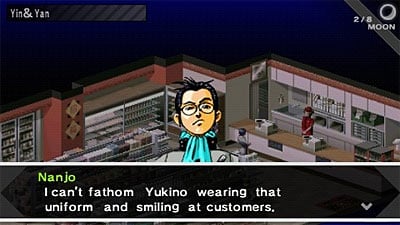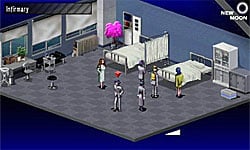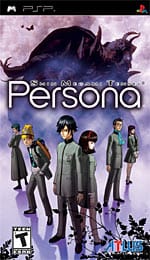Back to Basics
Although the Persona series has been around for more than a decade, it didn’t really catch fire until the release of Persona 3, two years ago. This game blended an engaging story and a unique battle system with some interesting decision-making elements, and it went on to become a stateside sensation. After the repeat success with Persona 4, fans were clamoring for more. While we all wait for the eventual announcement of Persona 5, we will be treated to a look at the past.

The original Persona (then named Revelations: Persona) came out 13 years ago, and it had one of the worst localizations in the history of video games. With altered characters, cut stages, and text that didn’t exactly make sense, the game barely resembled its former self, and didn’t perform as well as it could have. However, more than a decade later, Persona has finally been released on the PSP with all of its original features, plus a few new ones!
The game’s setup will feel familiar to veterans of the series, and it revolves around a demonic invasion brought on by an evil corporate genius. Throw in your average teenage character archetypes and you’ve got yourself a story. Although the story can’t compete with the epic scale of Persona 3 and 4, it is entertaining enough, and the occult themes that fans have come to expect from the series are definitely present in Persona. The game, despite its age, even features some selectable dialogue, and the choices your character makes can lead to two possible ending scenarios.
Although the story aspect of Persona doesn’t quite live up to the caliber of its successors, one area that has definitely stood the test of time is the battle system. All of the Persona games feature characters that can summon otherworldly creatures, known as Persona, to fight the evils of their respective universes. In this entry, Persona can be created, evolved, and customized using the signature Velvet Room. In addition to using Personas in battle, the characters in your party can also use standard attacks and wield guns to take down enemies from afar.

Of course, one of the most memorable aspects of the battle system is the negotiation system. Instead of just going after your enemy, you can try using a number of character-specific actions to scare or entice them into giving you a spirit card (which will aid in Persona development later). This aspect of the title makes grinding through the game’s many random encounters a lot more fun, and it also helps you develop your Persona army. Negotiating with characters can also earn you experience boosts and special items, so it is definitely a skill worth using and mastering.
Although the battle system itself has not been altered, there are some minor improvements that have been made to the PSP remake that help streamline some of the more cumbersome aspects of the original. The most useful of these changes is the option to turn off battle animations. These animations, while nice to look at once or twice, extend the length of even the briefest of battles by two or three minutes, and when you have a random encounter happening every few minutes, it can really put a drag on your progress, so this option is certainly a welcome one. Another improvement is the ability to change the game’s difficulty setting. Those who played the original will remember that the localization was severely hampered in terms of difficulty, but this one rectifies this issue with easy, average, and experienced difficulty settings.

As faithful as Persona on the PSP has stayed to the original’s story and battle system, there are a few things that are different. The most notable of these, of course, would have to be the visuals. Even when it was originally released in the mid-nineties, the graphics were not exactly cutting-edge and the original was highly criticized for its dated look. However, the cinema scenes on the new PSP version have been completely re-done using highly stylized cel-shaded animation. The animation is of very high-quality, and a vocal track has also been added.
However, the in-game graphics didn’t look like they were touched up as much as the cutscenes and, unfortunately, this is where Persona shows its age the most. Most of the levels are presented as floating stages, which look like dioramas against a non-descript background. Once you enter a dungeon area, the view then switches to first-person. While this helps to get rid of the diorama effect, it makes precise movement tough, and it can be quite jarring if you are trying to navigate using a certain path (like one that will net you fewer random encounters). Still, for a cleaned-up PlayStation game, Persona doesn’t look terrible, and despite the lack of detail and the weird first-person moments, Persona still looks satisfactory on the PSP.

One of the biggest complaints about the original localization of Persona was that it cut a fairly substantial quest from the game, known as the Snow Queen quest. This quest allows the user to completely abandon the game’s original goal (finding the evil corporate mastermind and reversing his plans) and instead gives you an alternate goal, to reverse the damage done to your school by an ancient mask. This quest, while it doesn’t have a lot to do with the game’s plot at-large was sorely missed in the original, but fans will certainly enjoy its reinstatement in the PSP version.
As far as the sound goes, Persona uses a mix of old and new elements to create an excellent audio scheme. All of the main characters are voiced during cinema scenes, and the voice actors do a great job of conveying the teenage drama present in the storyline. The music has been repurposed from the original title and mixed with some new tunes by original composer, Shoji Meguro. Some new vocal tracks have also been added, featuring performances by Persona 3 vocalist Yumi Kawamura. The sound in this game is quite excellent – it’s truly a pleasure to listen to.
The original Persona was a great game when it was released. However, some incredibly poor localization choices turned it into a too-easy, incomplete, and at times, nonsensical experience. However, more than a decade later, the game has been re-localized and given a facelift. The result is a highly polished JRPG that is a must-play for fans of the Persona series. Although the visuals do look a little dated, the gameplay is as solid as the most modern entries in the series and certainly won’t disappoint fans or newcomers.
RATING OUT OF 5 RATING DESCRIPTION 3.9 Graphics
The in-game graphics are minimalistic and not incredibly detailed. However, remastered cinema scenes look great. 3.8 Control
Battle controls work fine, but the first-person dungeon-crawling can be a little jarring. 3.9 Music / Sound FX / Voice Acting
Theme music ranges from spunky to morose and the title theme is incredibly catchy. 4.2 Play Value
Persona is a very long game, and you’d be hard-pressed to finish it under 30 hours. With plenty of Persona to create and the option to follow the newly-localized Snow Queen quest, there is plenty to do in Persona. 4.0 Overall Rating – Great
Not an average. See Rating legend above for a final score breakdown.
Game Features:
